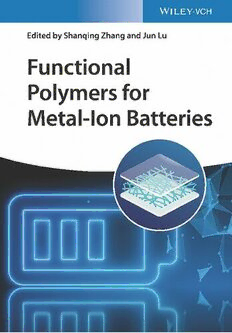
Functional Polymers for Metal-Ion Batteries PDF
Preview Functional Polymers for Metal-Ion Batteries
FunctionalPolymersforMetal-IonBatteries Functional Polymers for Metal-Ion Batteries Edited by Shanqing Zhang and Jun Lu Editors AllbookspublishedbyWILEY-VCHarecarefully produced.Nevertheless,authors,editors,and Prof.ShanqingZhang publisherdonotwarranttheinformation GriffithUniversity containedinthesebooks,includingthisbook, SchoolofEnvironmentandScience tobefreeoferrors.Readersareadvisedtokeep GoldCoastCampus,QLD4222 inmindthatstatements,data,illustrations, Australia proceduraldetailsorotheritemsmay inadvertentlybeinaccurate. Prof.JunLu ZhejiangUniversity LibraryofCongressCardNo.:appliedfor CollegeofChemical&Biological Engineering BritishLibraryCataloguing-in-PublicationData 38Zhe-daRoad Acataloguerecordforthisbookisavailable ZhejiangProvince fromtheBritishLibrary. 310027Hangzhou China Bibliographicinformationpublishedby theDeutscheNationalbibliothek CoverImages:©DmitryKovalchuk/ TheDeutscheNationalbibliotheklists Shutterstock;Immersion thispublicationintheDeutsche Imagery/Shutterstock Nationalbibliografie;detailedbibliographic dataareavailableontheInternetat <http://dnb.d-nb.de>. ©2023WILEY-VCHGmbH,Boschstraße12, 69469Weinheim,Germany Allrightsreserved(includingthoseof translationintootherlanguages).Nopartof thisbookmaybereproducedinanyform–by photoprinting,microfilm,oranyother means–nortransmittedortranslatedintoa machinelanguagewithoutwrittenpermission fromthepublishers.Registerednames, trademarks,etc.usedinthisbook,evenwhen notspecificallymarkedassuch,arenottobe consideredunprotectedbylaw. PrintISBN:978-3-527-35068-1 ePDFISBN:978-3-527-83859-2 ePubISBN:978-3-527-83860-8 oBookISBN:978-3-527-83861-5 Typesetting Straive,Chennai,India v Contents AbouttheEditors ix AbouttheContributors xi Introduction xv 1 PolymericElectrodeMaterialsinModernMetal-ion Batteries 1 ZhenzhenWu,PanYang,ShanqingZhang,andShengLi 1.1 Introduction 1 1.2 ClassificationofPEMs 5 1.2.1 Carbonyls 9 1.2.2 Organosulfur 11 1.2.3 OrganicNitrogen(N) 11 1.2.4 ConductingPolymers 13 1.2.5 OrganicRadicals 15 1.2.6 SuperlithiatedCompounds 16 1.3 MolecularEngineeringofPEMs 17 1.3.1 SpecificEnergyDensity 17 1.3.2 PowerDensity 19 1.3.3 CyclePerformance 21 1.4 MorphologicalEngineeringofPEMs 22 1.4.1 0DPEMs 23 1.4.2 1DPEMs 24 1.4.3 2DPEMs 25 1.4.4 3DPEMs 26 1.5 ApplicationsofPEMs 28 1.5.1 LIBs 28 1.5.2 SIBs 31 1.5.3 PIBs 34 1.5.4 MultivalentMIBs 36 1.5.4.1 ConductingPolymers 36 1.5.4.2 CarbonylCompounds 38 1.5.4.3 ImineCompounds 39 vi Contents 1.6 ConclusionandPerspectives 41 1.6.1 Conclusion 41 1.6.2 Perspectives 42 References 43 2 PolymericBindersinModernMetal-ionBatteries 61 HaoChen,ShanqingZhang,GaoLiu,andChengYan 2.1 Introduction 61 2.2 GeneralBindingMechanisms 62 2.3 ClassificationofBinders 63 2.4 StrategiesofBinderDesign 64 2.4.1 StrategiestoEnhanceMechanicalInterlocking 66 2.4.2 StrategiestoEnhanceInterfacialBonding 69 2.4.3 BinderswithMultipleFunctionalities 71 2.5 ApplicationofBindersforDifferentEnergyMaterials 76 2.5.1 High-VoltageCathodes 76 2.5.2 Li–SBatteries 81 2.5.3 SiliconAnode 88 2.5.4 Sodium-IonBatteries 95 2.5.5 Sodium–SulfurandPotassium–SulfurBatteries 98 2.6 ConclusionandPerspective 101 References 102 3 PolymericSeparatorinModernMetal-ionBatteries 119 MengtingZheng,JunLu,andTiefengLiu 3.1 Introduction 119 3.2 FunctionsofPolymericSeparatorsinMetal-ionBatteries 120 3.2.1 EssentialPropertiesofPolymericSeparators 121 3.2.1.1 Porosity 121 3.2.1.2 Wettability 122 3.2.1.3 Strength 122 3.2.1.4 Thickness 123 3.2.2 DesirableFunctionsofPolymericSeparators 123 3.3 ClassificationofPolymericSeparators 124 3.3.1 NonwovenSeparators 124 3.3.2 NanoporousMembraneSeparators 124 3.3.3 MicroporousMembraneSeparators 124 3.3.4 CompositeMembraneSeparators 125 3.4 FunctionalPolymericSeparatorsforModernMetal-ionBatteries 126 3.4.1 Thermal-resistantSeparators 126 3.4.2 ReversibleThermallyInducedShutdownSeparators 128 3.4.3 SeparatorsforMetalDendriteGrowthInhibition 129 3.4.4 SeparatorsforStoppingtheShuttleEffect 131 3.4.5 StretchableSeparatorsforFlexibleBatteries 133 3.4.6 TheSeparatorasLiSourceforRecyclingDegradedCathode 134 Contents vii 3.4.7 SuperWettableSeparatortoBoostIonicDiffusion 135 3.5 ManufacturingTechniquesofPolymericSeparators 136 3.5.1 ConventionalManufacturingTechniquesofPolymericSeparators 136 3.5.2 ModernManufacturingTechniquesofFunctionalPolymeric Separators 138 3.6 ConclusionandPerspectives 139 References 140 4 PolymericElectrolytesinModernMetal-ionBatteries 147 ShuxingWU,BoyangZhang,HuixianXie,andZhanLin 4.1 Introduction 147 4.2 IonTransportinPolymericElectrolytes 147 4.2.1 SolidPolymericElectrolytes 148 4.2.2 GelPolymericElectrolytes 149 4.2.3 CompositePolymericElectrolytes 149 4.3 PropertyStudy 150 4.3.1 ThermalAnalysis 150 4.3.2 StructuralAnalysis 151 4.3.3 DiffractionTechnique 151 4.3.4 ConductivityMeasurement 152 4.3.5 NuclearMagneticResonance(NMR) 153 4.3.6 ModelingandTheory 153 4.4 ClassificationsofPolymericElectrolytes 154 4.4.1 SolidPolymerElectrolytes 154 4.4.1.1 DispersedSolidPolymerElectrolytes 154 4.4.1.2 Intercalated/ExfoliatedSolidPolymerElectrolytes 155 4.4.1.3 LiquidCrystalContainingPolymerElectrolytes 155 4.4.2 GelPolymerElectrolytes 155 4.4.2.1 Ionic-Liquid-basedPolymerElectrolytes 155 4.4.2.2 GelPolymerElectrolytes 155 4.5 StrategiesinDesigningSolid-stateElectrolytes 156 4.5.1 PurePolymericElectrolytes 156 4.5.1.1 ClassificationofPureSolidPolymerElectrolytes 156 4.5.1.2 CompositionofPureSolidPolymerElectrolytes 156 4.5.1.3 PolymerHosts 157 4.5.1.4 ConductiveSalt 158 4.5.1.5 ResearchStrategy 159 4.5.2 GelPolymericElectrolyte 160 4.5.2.1 Component 160 4.5.2.2 PolymerMatrix 160 4.5.2.3 Plasticizer 163 4.5.2.4 ConductiveLithiumSalt 164 4.5.3 Polymeric–CeramicCompositeElectrolyte 164 4.5.3.1 ComponentsofPolymer–CeramicCompositeElectrolytes 165 4.5.3.2 ClassificationofPolymer–CeramicCompositeElectrolytes 165 viii Contents 4.5.3.3 ResearchStrategy 167 4.6 ApplicationofPolymerElectrolytesinAll-solid-stateBatteries 167 4.6.1 LithiumBatterySystem 167 4.6.2 SodiumBatterySystem 170 4.6.3 Li-SBatterySystem 171 4.7 SummaryandProspect 174 References 175 Index 191 ix About the Editors Prof.ShanqingZhangobtainedhisPhDdegreeinelectro- chemistryin2001atGriffithUniversity,Australia.Hewas awardedtheAustraliaResearchCouncilFutureFellowship for 2009–2013 and promoted to full professor and theme leaderatGriffithUniversityin2016.Currently,Heisafel- low of the Royal Chemical Society (UK) and a Fellow of the Royal Australian Chemical Institute (Australia). Prof. Zhang has been working on the design and synthesis of nanomaterialsandfunctionalpolymersforenergyconver- sion and storage devices as well as the development of sustainable,recyclablebatterytechnology. Prof. Jun Lu completed his PhD in 2009 from the DepartmentofMetallurgicalEngineeringattheUniversity of Utah. He then worked as a postdoctorate under a DOE-EERE postdoctoral fellowship (Vehicles Technology Program (2011–2013)) at Argonne National Laboratory, beforebeingpromotedtohiscurrentpositionasachemist (staffscientist)atArgonneNationalLaboratory.Prof.Lu’s research interests mainly focus on Li-ion battery technol- ogy, including Li-O batteries with both open and close 2 configurations, high-energy cathode materials for Li-ion batteries,high-energysiliconanode,solid-stateelectrolyte, cathodedesignforLi-Sbatteries,newmaterialsforNa-ion andNa-airbatteries. xi About the Contributors Dr. Hao Chen was awarded his bachelor’s degree in 2014 and master’s degree in 2017 from Central South University, China, and PhD degree in 2021. He was the only Chancellor’s medal winner of 2021 in Griffith Sci- ence, Australia. Since 2022, he has been working as a researchfellowattheCentreofCatalysisandCleanEnergy, GriffithUniversity,Australia.Hiscurrentresearchinterests includethedesignandsynthesisoffunctionalbindersand all-solid-statelithium-ionbatteries. Dr.ShengLiobtainedhisPhDdegreein2015fromGriffith University,Australia.AfterpostdoctoralresearchatGriffith University in 2016, he is now a professor working at the Institute of Advanced Materials, Nanjing Tech University. Hiscurrentresearchinterestsincludeenergystoragemate- rials and devices (metal-ion batteries and metal-air bat- teries) and other electrochemical techniques for clean energy. Prof. Zhan Lin obtained his PhD degree from North Carolina State University in 2010. After that, he worked asapostdoctoralresearchassociateatOakRidgeNational LaboratoryandtheUniversityofCalifornia-Berkeleyfrom 2011to2013.HereturnedtoChinaandbecameafullprofes- sorin2014,andnowheisaprofessorandresearchleaderin theSchoolofChemicalEngineeringandLightIndustryat GuangdongUniversityofTechnology,China.Hisresearch mainly focuses on advanced materials for energy storage andconversion.
